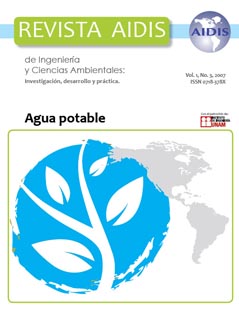Tubular solar distillation: An option to obtain drinking water from saline waters to supply rural communities
Main Article Content
Abstract
This study presents the development of two systems of tubular solar still based in works made by the University of California in the United States in the 50’s, and by Japanese investigators in 2003 (Teruyuki et. al.). These distillers were evaluated and compared with the efficiencies obtained in the work of Teruyuki, to determinate, if these prototypes produce enough drinking water for supply five members of a family (2 liters per person per day, It is the minimum requirements for ingestion) which lives in rural areas with problems of brackish water. The objective of the present work was to design a solar desalination system of easy construction, installation, operation and little maintenance for rural communities (family level). The goal of these distillers is to obtain 10 liters of drinking water per day and it is for 5 members of one family. The evaluated reactors were: a modified tubular solar still (TSS), a concentrator parabolic compound (CPC) mounted in a TSS and a conventional stairway still (CSS). The material of the body of the TSS was of acrylic of 6 inch of diameter and one meter of length, the trough of the TSS and the stairs of the conventional distiller were cover with epoxy black paint of food type degree. The units of this system were: storage tank (450 L), solar heater (for preheated purposes) and the three distillers (TSS, CPC and CSS) which worked at the same time. In the storage tank was prepared an artificial solution of salt, sea salt was used in concentration of 5 to 12 g/L diluted with tap water. The distillers operated during 121 days; the preheated water was distributed in the 3 reactors at the same time. The measured parameters were: conductivity, % of salinity, total dissolved solids (TDS), pH, volume of distilled (fresh water), volume of brine and solar intensity. After 60 days of operation volatile organic compounds were analyzed. The results showed that the best production in liters per day was the CSS, however the maximum production by occupied area per day was obtained with the DTS 5.6 L/m2 d with preheating, and without preheating the production was reduced to 2.96 L/m2 d. The arithmetic mode production for the DTS with preheating was of 1.79 L/m2 d and 0.44 L/m2 d for the CSS. It indicates that is necessary to build 36 DTS and there required 5.6 m2 of area or 29 conventional stairway still with 24.36 m2 occupied area. The construction and installation cost of each type of distiller would be of 3,507 USD for the DTS and 7,482 USD for the CSS, included the preheated, hydraulic installation, and the distillers (DTS or CSS respectability). In both case, the cost is very high for rural communities, for what other materials must be studied to build the distillers. Also volatile compounds in the fresh water were evaluated after 60 days of operation and it was found chloroform and Toluene at concentrations over the European Union norms for what it is necessary to monitor the water quality of the fresh water, once selected the materials for building them.
Article Details
How to Cite
[1]
Fuentes Díaz, M., González Herrera, A., Montellano Palacios, L., Chacón Castillo, J.M., Ramírez González, A. and Garrido Hoyos, S.E. 2009. Tubular solar distillation: An option to obtain drinking water from saline waters to supply rural communities. Revista AIDIS de ingeniería y ciencias ambientales: Investigación, desarrollo y práctica. 1, 3 (Nov. 2009).
